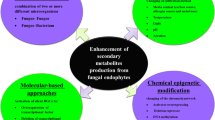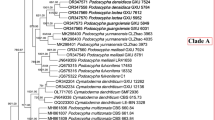Abstract
Agaricus brasiliensis is a medicinal mushroom native to Brazil. It was first identified as Agaricus blazei and its scientific name continues to be debated. We examined the cytology of different Brazilian commercial strains of A. brasiliensis and the nuclear behavior of strain CS1 during basidiospore development using fluorescent microscopy. All strains have multinucleate hyphae and no significant differences in nuclei numbers were observed between them. Basidia from A. brasiliensis strain CS1 are typically tetrasporics and produce binucleate basidiospores, demonstrating that a postmeiotic mitosis occurs during basidiospore development. This result suggests that A. brasiliensis is primarily a heterothallic species.








Similar content being viewed by others
References
Callac P, Billete C, Imbernon M, Kerrigan RW (1993) Morphological, genetic, and interfertility analyses reveal a novel, tetrasporic variety of Agaricus bisporus from the Sonoran Desert of California. Mycologia 85:835–851 doi:10.2307/3760617
Duncan EG, Galbraith MH (1972) Post-meiotic events in the Homobasidiomycetidae. Trans Br Mycol Soc 58:387–392
Fan LF, Soccol AT, Pandey A, Soccol CR (2007) Effect of nutritional and environmental conditions on the production of exo-polysaccharide of Agaricus brasiliensis by submerged fermentation and its antitumor activity. LWT-Food Sci Technol 40:30–35
Ferreira DF (2000) SISVAR—Sistema de análise de variância para dados balanceados: programa de análises estatísticas e planejamento de experimentos, versão 4,3. UFLA/DEX, Lavras
Heinemann P (1993) Agaricaceae des regions intertropicales d’Amérique du Sud: Agarici Austroamericani VII. Bull Jard Bot Nat Belg/Bull Nat Plantentuin Belg 62:355–384 doi:102307/3668282
Horton TR (2006) The number of nuclei in basidiospores of 63 species of ectomycorrhizal Homobasidiomycetes. Mycologia 98:233–238
Ito H, Shimura K, Itoh H, Kawade M (1997) Antitumor effects of a new polysaccharide-protein complex (ATOM) prepared from Agaricus blazei (Iwade strain 101) “Himematsutake” and its mechanism in tumor-bearing mice. Anticancer Res 17:277–284
Kamzolkina OV, Volkova VN, Koslova MV, Pancheva EV, Dyakov YT, Callac P (2006) Karyological evidence for meiosis in the three different types of life cycles existing in Agaricus bisporus. Mycologia 98:763–770
Kaneno R, Fontari LM, Santos SA (2004) Effect of extracts from Braziliam sun-mushroom (Agaricus blazei) on the NK activity and lymphoproliferative responsiveness of Ehrlich tumor-bearing mice. Food Chem Toxicol 42:909–916 doi:10.1016/j.fct.2004.01.014
Kawagishi H, Inagaki R, Kanao T, Shimura K, Ito H, Hagiwara T, Nakamura T (1989) Fractionation and antitumor activity of the water-insoluble residue of Agaricus blazei fruiting bodies. Carbohydr Res 186:267–273
Kerrigan RW (2005) Agaricus subrufescens, a cultivated edible and medicinal mushroom, and its synonyms. Mycologia 97:12–24
Kerrigan RW (2007) Inclusive and exclusive concepts of Agaricus subrufescens peck: a reply to Wasser et al. Int J Med Mushrm 9:79–84. doi:10.1615/IntJMedMushr.v9.i1.100
Kerrigan RW, Ross IK (1987) Dynamic aspects of basidiospore number in Agaricus. Mycologia 79:204–215. doi:10.2307/3807654
Mizuno T (1995) Kawariharatake, Agaricus blazei Murill: medicinal and dietary effects. Food Rev Int 11:167–172
Mizuno M, Kawakami S (2006) An immunomodulating polysaccharide in Agaricus brasiliensis S. Wasser et al. (Agaricomycetidae) activates macrophages through toll-like receptor 4. Int J Med Mushrm 8(3):223–229 doi:10.1615/IntJMedMushr.v8.i3.40
Mizuno T, Hagiwara T, Nakamura T, Ito H, Shimura K, Sumiya T, Asakura A (1990) Antitumor activity and some properties of watersoluble polysaccharides from “Himematsutake”, the fruiting body of Agaricus blazei Murrill. Agric Biol Chem 54:2889–2896
Raper C (1976) Sexuality and life cycle of the edible wild Agaricus bitorquis. J Gen Microbiol 95:54–66
Raper C, Raper JR, Miller RE (1972) Genetic analysis of the life cycle of Agaricus bisporus. Mycologia 64:1088–1117 doi:10.2307/3758075
Roane CW (1952) A method of preparing fungi for cytological studies. Phytopathology 42:480
Robinow CF (1975) The preparation of yeast for light microscopy. In: Prescot T, David M (eds) Methods Cell Biol 1:12–21
Saksena KN, Marino R, Haller MN, Lemke PA (1976) Study on development of Agaricus bisporus by fluorescent microscopy and scanning electron microscopy. J Bacteriol 126:417–428
Shin G-G, Meguro S, Kawachi S (1997) The active constituent in yeast extract for fruit body formation of Lentinula edodes. Can J Microbiol 43:1202–1204
Tommerup IC, Bougher NL, Malajczuk N (1991) Laccaria fraternal, a common ectomycorrhizal fungus with mono- and bi-sporic basidia and multinucleate spores: comparison with the quadristerigmate, binucleate spored L. laccata and the hypogeous relative Hydnagium carneum. Mycol Res 95:689–698
Tomizawa MM, Souza Dias E, Assis LJ, Gomide PHO, Santos JB (2007) Genetic variability of mushroom isolates Agaricus blazei using markers RAPD. Cienc Agrotec 31:1242–1249
Wasser SP (2007) Molecular identification of species of the genus Agaricus. Why should we look at morphology? Int J Med Mushrm 9:85–88 doi:10.1615/IntJMedMushr.v9.i1.110
Wasser SP, Didukh MY, Amazonas MAL, Nevo E, Stamets P, Eira AF (2002) Is a widely cultivated culinary-medicinal Royal Sun Agaricus (the Himematsutake Mushroom) indeed Agaricus blazei Murrill? Int J Med Mushrm 4:267–290
Wasser SP, Didukh MY, Amazonas MAL, Nevo E, Stamets P, Eira AF (2005) Is a widely cultivated culinary-medicinal royal sun Agaricus (Champignon do brazil, or the himematsutake mushroom) Agaricus brasiliensis S. Wasser et al indeed a synonym of A. subrufescens peck? Int J Med Mushrm 7:507–511
Acknowledgements
The authors wish to thank the Brazilian agencies “Fundação de Amparo a Pesquisa de Minas Gerais” (FAPEMIG) and “Conselho Nacional de Desenvolvimento científico e Tecnológico” (CNPq) for financial support and Alan Castle (Brock University, St. Catharines,ON Canada) for use of his laboratory.
Author information
Authors and Affiliations
Corresponding author
Rights and permissions
About this article
Cite this article
Souza Dias, E., Labory, C.R.G., Herrera, K.M.S. et al. Cytological studies of Agaricus brasiliensis . World J Microbiol Biotechnol 24, 2473–2479 (2008). https://doi.org/10.1007/s11274-008-9769-4
Received:
Accepted:
Published:
Issue Date:
DOI: https://doi.org/10.1007/s11274-008-9769-4




